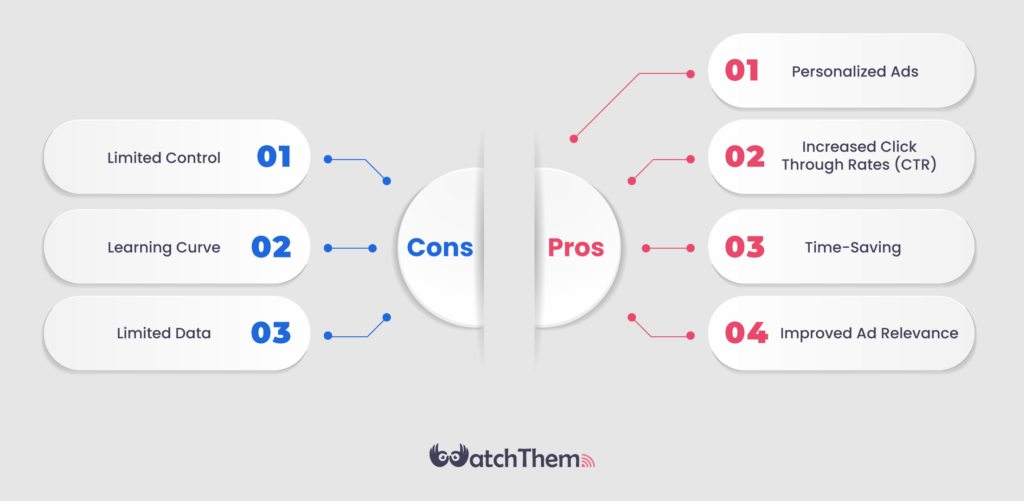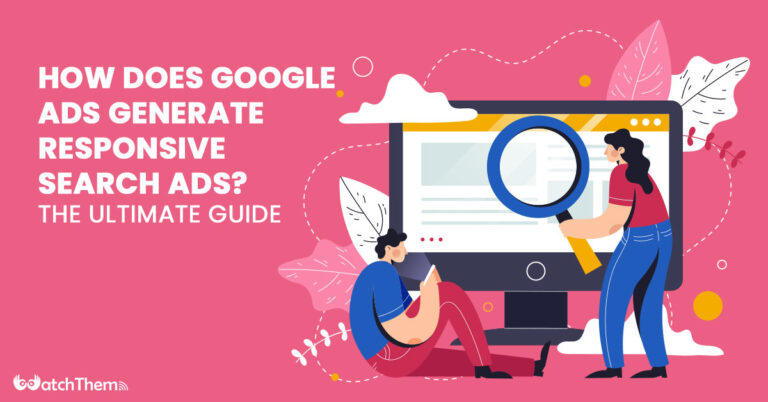Page Contents
Have you ever wondered ‘How does Google ads generate responsive search ads?’ Google Ads has become an essential tool for businesses looking to attract and convert potential customers online. It allows advertisers to create and display ads to a targeted audience, based on search queries, interests, and demographics. One of the latest features of Google Ads is the responsive search ad.
It’s a powerful e-commerce marketing tool that can generate multiple headlines and descriptions for your ads, maximizing the chances of attracting clicks and optimizing your conversion.
But how can you ensure that your ad campaigns are converting visitors into customers? That’s where WatchThemLive comes in. This conversion rate optimization tool can help businesses increase their website’s conversion rates and improve their overall revenue.
In this article, we’ll explore how does Google Ads generate Responsive Search Ads, the pros and cons of using this ad format, and how WatchThemLive can help you take your online advertising to the next level.
What are Responsive Search Ads
First things first, let’s learn about the basics. Responsive search ads are Google Ads that automatically generate and display multiple headlines and descriptions to a targeted audience. It’s an e-commerce marketing tool that helps advertisers to create more personalized and relevant ads for their audience.
With responsive search ads, you can enter multiple headlines and descriptions, and Google will test different combinations to determine the best-performing ads for your campaign.
How Does Google Ads Generate Responsive Search Ads
by using machine learning algorithms, Google Ads automatically combines the different ad headlines and descriptions that advertisers provide into unique ad combinations that are tailored to each individual user’s search query.
Advertisers provide a few variations of headlines and descriptions, and then Google’s system dynamically assembles them into ads that are relevant to the user’s search query, ad placement, and device type.
This helps to ensure that the ads are more personalized and relevant to the user, which can lead to higher click-through rates and better overall performance. Google’s machine learning algorithms continuously test and optimize the ads over time, learning from user behavior and performance data to deliver more effective ads in the future.
When creating a Google responsive search ad, you can enter up to 15 headlines and four descriptions. Google Ads will test different combinations of these headlines and descriptions to determine the best-performing ads for your campaign.
The machine learning algorithm analyzes the relevance, quality, and performance of each headline and description to identify the best-performing ads. Then, you can use website analytics tools to gain insight into the success of your ad campaigns.
So here goes the answer to ‘how does Google Ads generate responsive search ads’!
Examples of Successful RSA Campaigns and Ad Combinations.
One of the benefits of using Google Responsive Search Ads is the ability to create multiple ad combinations automatically, allowing advertisers to test different variations and find the best-performing combinations.
Here are some examples of successful RSA campaigns and ad combinations:
#1 Incorporating the User’s Search Query
By including the user’s search query in the headlines and descriptions of the ad, you can make the ad more relevant and increase the chances of it being clicked.
For example, if someone searches for “best pizza delivery,” an ad with headlines like “Best Pizza Delivery Near You” and “Get Your Pizza Delivered in Minutes” could perform well.
#2 Highlighting Unique Selling Points
If your business offers unique features or benefits that set you apart from competitors, highlighting them in the ad can be an effective strategy. For example, if you offer free shipping on all orders, including that in the ad could attract more clicks and conversions.
#3 Using Emotive Language
Advertisers can use emotive language in their headlines and descriptions to appeal to potential customers’ emotions and increase their interest in the product or service, resulting in an increased retention rate. For example, using phrases like “Get the Best Deals Today” or “Experience Unmatched Quality” could create a sense of urgency and desire.
#4 Testing Multiple Headlines and Descriptions
As RSA allows advertisers to input up to 15 headlines and 4 descriptions, testing multiple combinations of these assets can help identify the best-performing ad variations. This can involve testing different headline and description lengths, messaging, and tone.
By testing different ad combinations and analyzing the performance of each, advertisers can optimize their RSA campaigns for maximum impact and achieve their marketing goals.
It’s important to note that what works for one business may not work for another, so it’s essential to continually review and adjust RSA campaigns to ensure they’re meeting your specific needs.
Maximizing Your RSA Campaign Performance With WatchThemLive
While there are many ways to optimize your Responsive Search Ads (RSA) campaign performance, using a CRO tool like WatchThemLive can take your efforts to the next level.
Here’s how WatchThemLive can help you maximize your RSA campaign performance:
#1 User Behavior Analytics
WatchThemLive is a great behavioral analytic tool that can help you understand how users interact with your ads and website. By analyzing user behavior, you can identify pain points in the user journey and optimize your ads and website to improve conversions.
#2 Heatmaps
If you’ve already heard about heatmaps, you know how helpful they can be. Heatmaps allow you to see where users are clicking on your ads and website, which can help you identify areas of high engagement and optimize your ad placements for maximum impact.
#3 Session Replay
WatchThemLive’s session replay feature lets you watch real-time user sessions, giving you an inside look at how users are interacting with your ads and website. This can help you identify issues with your ads or website and make necessary improvements.
#4 Funnel Visualization
WatchThemLive allows you to see the user journey from ad click to conversion, giving you insights into where users drop off and how to optimize your ads and website for better conversion rates.
By using WatchThemLive to optimize your RSA campaigns, you can increase your ad relevance, improve your ad performance, and achieve better results.
So make sure to Sign up today and get your FREE plan!
Pros and Cons of Responsive Search Ads
Now that you know the answer to ‘how does Google ads generate responsive search ads’, it’s time to learn about the advantages and disadvantages of this feature.


Pros
There are many benefits to knowing how does Google Ads generate responsive search ads and it can help flourish your business. Here are a few of them.
#1 Personalized Ads
With responsive search ads, you can create multiple headlines and descriptions that are personalized to your audience. This helps to improve the relevance of your ads, making them more attractive to potential customers, and optimizing your market research strategies.
#2 Increased Click-Through Rates (CTR)
Google Responsive search ads generate multiple headlines and descriptions, increasing the chances of attracting clicks and conversions. Google Ads will display the best-performing ads to your audience, maximizing your CTR.
#3 Time-Saving
Creating multiple ads can be time-consuming, but responsive search ads save time by automatically generating and testing different combinations of headlines and descriptions.
#4 Improved Ad Relevance
Google Ads machine learning algorithms analyze the content of your website, keywords, and ad groups to create personalized headlines and descriptions that match the intent of the user’s search query. This helps to improve the relevance of your ads, making them more attractive to potential customers.
Cons
After learning how does Google Ads generate responsive search ads, now it’s time to learn what the pros of responsive search ads are, it’s time to get familiar with their cons.
#1 Limited Control
Unlike traditional ads, responsive search ads do not allow you to control the specific combinations of headlines and descriptions that appear in your ads. You can enter up to 15 headlines and four descriptions, but Google Ads will test different combinations to determine the best-performing ads.
#2 Learning Curve
Creating responsive search ads requires a bit of a learning curve. It can take some time to understand how to create effective headlines and descriptions that perform well in your campaigns.
#3 Limited Data
Since Google Ads determines the best-performing ads for your campaign, you may not have access to detailed data about which combinations of headlines and descriptions performed best. This can make it difficult to optimize your campaigns effectively.
How to Create Responsive Search Ads
Creating responsive search ads is a straightforward process. Here are the steps to follow:
- First, create a new ad group or select an existing one.
- Then, click on the “Ads & Extensions” tab and select “Responsive Search Ad.”
- Now, enter up to 15 headlines and four descriptions. Google Ads will test different combinations to determine the best-performing ads.
- Add a URL to your landing page and a path to display in the ad’s URL.
- And finally, save and submit your ad.
‘How Does Google Ads Generate Responsive Search Ads’ FAQs
So far, we tried to answer any questions you might have about Google Ads’ responsive search ads. Here are a few frequently asked questions to help you better understand this subject.
Q1. How Does Google Ads Generate Responsive Search Ads and Determine Which Ad Combinations to Show?
Google Ads uses signals such as search terms, device, location, and other contextual information to decide which ad combinations to show. It also uses historical performance data to predict which ad combinations will perform best for a particular search query.
Q2. Can I See Which Headlines and Descriptions Are Performing Best in My RSA?
Yes, advertisers can view the performance of each headline and description in the ad reports and adjust them to improve their ad’s performance.
Q3. How Many Headlines and Descriptions Can I Provide for My RSA?
Advertisers can provide up to 15 headlines and 4 descriptions for their RSA. Google Ads will then use these assets to create different ad combinations that are relevant to the user’s search query.
Q4. How Long Does It Take for Google Ads to Generate Ad Combinations for My RSA?
Google Ads typically generates ad combinations for RSA within a few hours of creating the ad. However, it may take longer for Google Ads to generate ad combinations for campaigns with limited data or low ad spending.
If it takes longer, you can get detailed information through the Google Ads help center.
Q5. Can I Use RSA in Combination With Other Ad Formats?
Yes, advertisers can use RSA in combination with other ad formats such as text, display, and video ads. However, it’s important to consider how different ad formats will work together to achieve your marketing goals and messaging.
Conclusion
In this article, we tried to answer ‘How does Google Ads generate responsive search ads’, as they can be a valuable tool for advertisers looking to improve their ad performance and reach their target audience more effectively.
While RSA has its limitations, such as limited control over ad combinations and lower ad prominence, the benefits of using this ad format may outweigh the drawbacks for some advertisers.
If you’re looking to take your online advertising to the next level, consider using WatchThemLive, a powerful conversion rate optimization tool that helps businesses create more effective ad campaigns and improve their online marketing results. So why not give it a try today?

